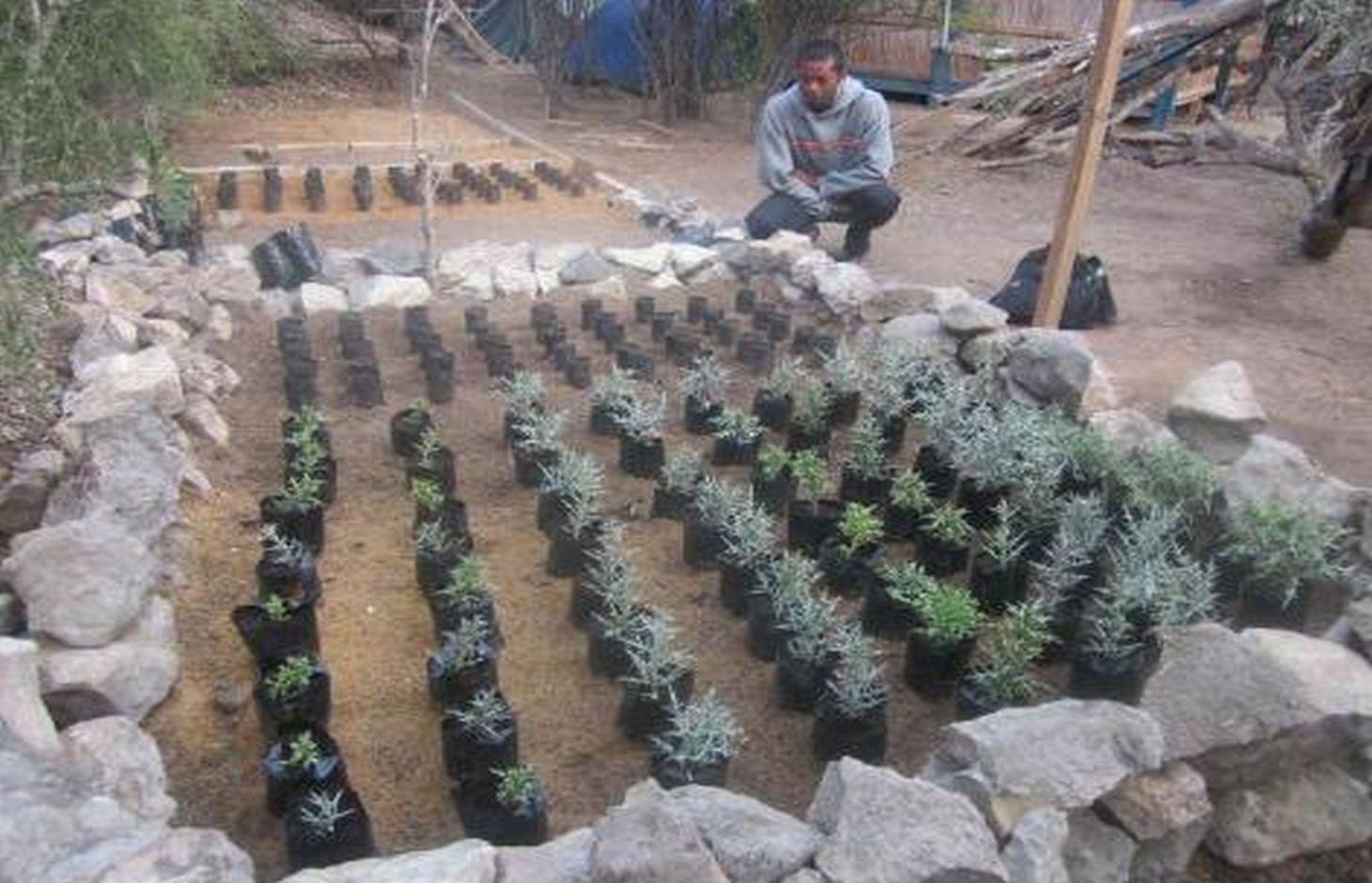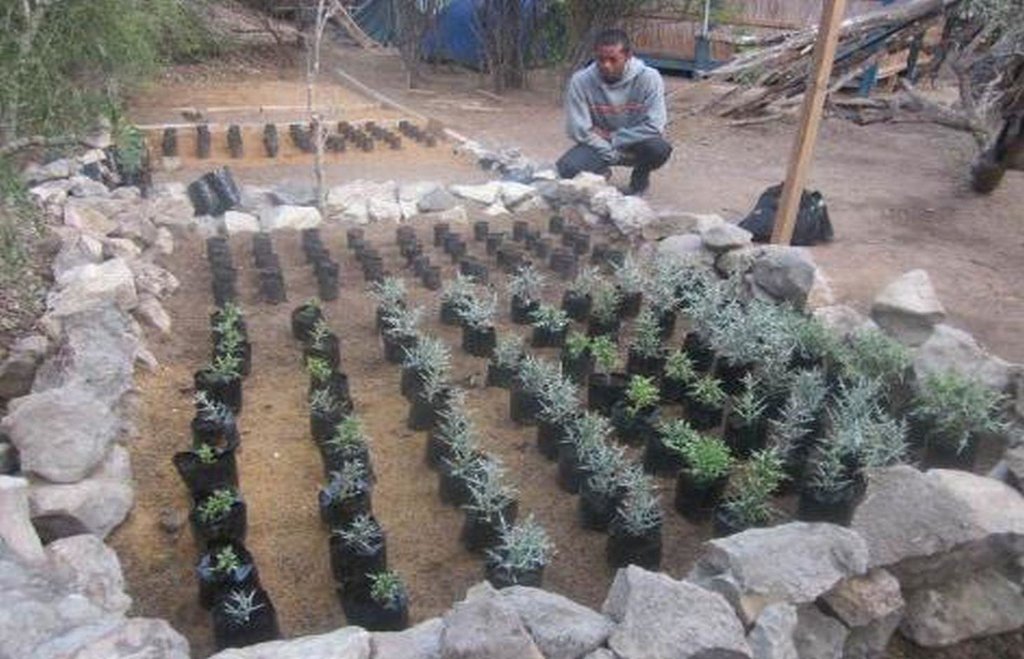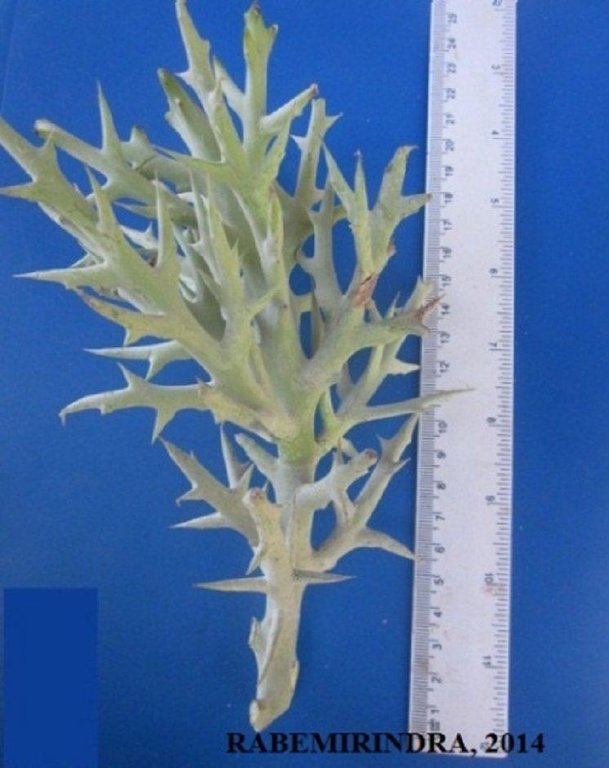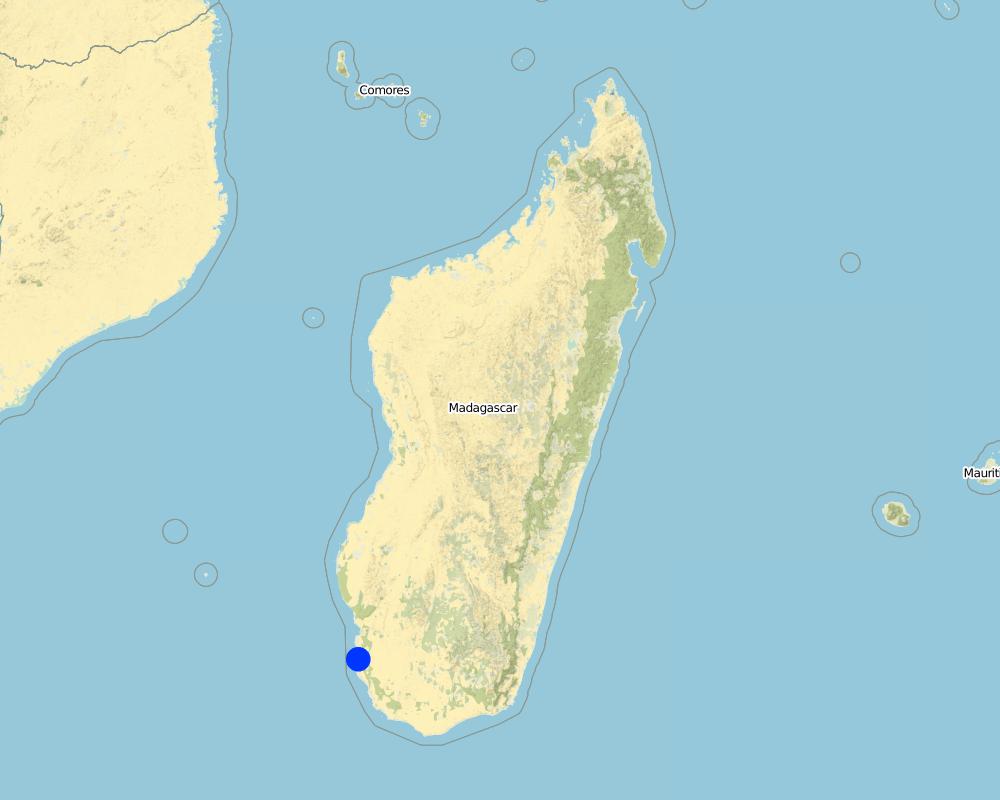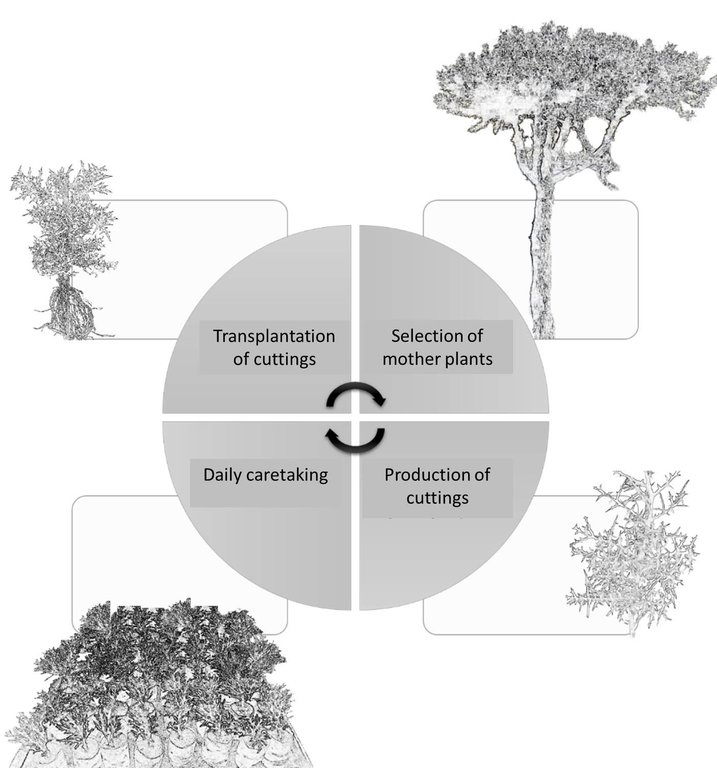Sustainable propagation of the fodder tree Euphorbia stenoclada (“samata”) [马达加斯加岛]
- 创建:
- 更新:
- 编制者: Johanna Goetter
- 编辑者: –
- 审查者: David Streiff, Fabian Ottiger, Alexandra Gavilano
technologies_1677 - 马达加斯加岛
- Sustainable propagation of the fodder tree Euphorbia stenoclada (“samata”): March 9, 2017 (inactive)
- Sustainable propagation of the fodder tree Euphorbia stenoclada (“samata”): May 3, 2017 (inactive)
- Sustainable propagation of the fodder tree Euphorbia stenoclada (“samata”): May 3, 2017 (inactive)
- Sustainable propagation of the fodder tree Euphorbia stenoclada (“samata”): Sept. 5, 2019 (public)
查看章节
全部展开 全部收起1. 一般信息
1.2 参与该技术评估和文件编制的资源人员和机构的联系方式
SLM专业人员:
Herinavalona Rabemirinra
University of Antananarivo
马达加斯加岛
SLM专业人员:
Yeddiya Ratovonamana
World Wildlife Fund (WWF Toliara)
马达加斯加岛
SLM专业人员:
Goum O. Antsonantenainarivony
University of Antananarivo
马达加斯加岛
有助于对技术进行记录/评估的项目名称(如相关)
Book project: Making sense of research for sustainable land management (GLUES)有助于对技术进行记录/评估的项目名称(如相关)
Sustainable Landmanagement in south-western Madagascar (SuLaMa / GLUES)有助于对技术进行记录/评估的机构名称(如相关)
Brandenburg Technical University (btu) - 德国有助于对技术进行记录/评估的机构名称(如相关)
University of Antananarivo - 马达加斯加岛有助于对技术进行记录/评估的机构名称(如相关)
World Wide Fund for Nature (WWF) - 瑞士1.3 关于使用通过WOCAT记录的数据的条件
编制者和关键资源人员接受有关使用通过WOCAT记录数据的条件。:
是
1.5 参考关于SLM方法(使用WOCAT记录的SLM方法)的调查问卷
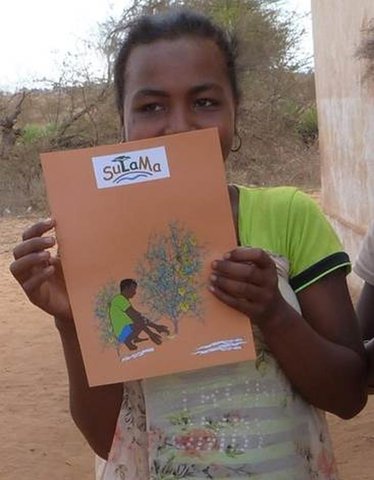
Increasing environmental awareness using comic-style illustrations as a … [马达加斯加岛]
Communicating and transferring scientific results and recommendations about sustainable land management to local people
- 编制者: Tobias Feldt
2. SLM技术的说明
2.1 技术简介
技术定义:
Propagation of “samata” cuttings for long-term provision of supplementary livestock fodder to reduce the pressure on natural vegetation.
2.2 技术的详细说明
说明:
The succulent evergreen tree Euphorbia stenoclada (“samata”) is the most important dry season fodder resource on the coastal plains grazing grounds in the Mahafaly Plateau region. To increase production, samata can be vegetatively propagated with cuttings raised in a nursery. The advantages are: (a) protection against livestock, (b) selection of the most appropriate planting stock to propagate and (c) easy watering. Cuttings should only be taken from mature trees 7-10 years old and 3-4 m high. The mother plants should be healthy, with few spines, and no previous cuttings taken. Cuttings are taken at the upper nodes of the branches, approximately 20-25 cm long and 0.5-1.5 cm diameter. Transport of the cuttings to the nursery should be carried out in the morning to avoid heat. For effective rooting, the cutting is planted 5 cm (1-2 nodes) into a humid substrate in a plastic pot or directly into the ground. Best results are achieved using white sea sand mixed with some organic material. Cuttings should be raised in a sunny location. During the first 15 days, the cuttings need to be watered once every morning. For the next 3-4 months, they need watering every second morning. 24 hours before transplantation from the nursery to the final destination, the cuttings should be abundantly watered. Rooted cuttings are transplanted into pits of 10 cm diameter and 15 cm depth, filled with the same substrate as used in the nursery. For 15 days, the transplants are watered on a daily basis, and afterwards every second day. After 30-45 days, the transplants are ready to survive without further care. If the planting location is open to roaming livestock, the cuttings need protection.
Purpose of the Technology: The samata tree naturally reproduces by seeds as well as by vegetative reproduction. However the German funded SULAMA research project has had most success with multiplication of the local variety with cuttings. This form of propagation is preferable as it is much faster and gives higher survival rates of the individuals: neither does it need much planting material, equipment or technical knowledge. Providing the villagers with the know-how, and assisting them to create local samata-nurseries, makes this technology promising. SuLaMa-WWF started this technique in April 2015, establishing 5 nurseries with 2,000 trees each (3 with village communities, 2 with local schools).
Establishment / maintenance activities and inputs: On the coastal plain of the Mahafaly plateau region, the climatic and edaphic conditions do not support livestock raising based mainly on grasses. For 6-7 months, the herders are dependent on supplementary fodder plants, especially samata. The tree is fed by cutting its branches and slicing them. However pressure on this resource has led to depletion of stocks around many villages: this results from increasing demand and reduced supply. Higher demand is the result of changed herd movements, especially a shorter transhumance period. Lower supply is attributed to decreased precipitation, overuse of trees leading to poor regeneration or even the death of trees, and reduced samata areas due to the expansion of private crop fields. The overuse of trees is triggered by the overall scarcity of this resource as well as an ongoing privatization of the historically common land resources.
2.3 技术照片
2.5 已应用该技术的、本评估所涵盖的国家/地区/地点
国家:
马达加斯加岛
区域/州/省:
Atsimo-Andrefana, Toliara
有关地点的进一步说明:
Toliara II, Beheloka
具体说明该技术的分布:
- 均匀地分布在一个区域
如果不知道精确的区域,请注明大致覆盖的区域:
- 10-100 平方千米
注释:
Application ongoing, the envisaged implementation area might be up to 1,000 km².
Map
×2.6 实施日期
如果不知道确切的年份,请说明大概的日期:
- 不到10年前(最近)
2.7 技术介绍
详细说明该技术是如何引入的:
- 在实验/研究期间
- 通过项目/外部干预
注释(项目类型等):
Project started with experimental trials of multiplication by cuttings in February 2014, first capacity development for land users through workshops on propagation technique in May 2015.
3. SLM技术的分类
3.2 应用该技术的当前土地利用类型

农田
- 一年一作
- 乔木与灌木的种植
年作 - 具体指明作物:
- 谷物类 - 玉米
- 根/块茎作物 - 红薯、山药、芋头/椰子,其他
- 根/块茎作物 - 木薯
乔木和灌木种植 - 指定作物:
- 饲料树木(朱缨花属、银合欢、前庭草等)
- cactus, Euphorbbia stenoclada, samata trees
每年的生长季节数:
- 1
具体说明:
Longest growing period from month to month: June - September

牧场
粗放式放牧:
- 半游牧畜牧业
集约放牧/饲料生产:
- 收割和携带/零放牧
注释:
Major cash crop annual cropping: Maize
Major food crop annual cropping: Cassava
Other crops annual cropping: Sweet potato
Major cash crop tree/shrub cropping: Samata (Euphorbia stenoclada)
Other crops tree/shrub cropping: Cactus
Major land use problems (compiler’s opinion): : Climatic constraints (especially low and erratic precipitation), deforestation, forest degradation, soil degradation, overgrazing, loss of arable land, fragmentation, low availability of surface and (very saline) ground water, privatization of common pool resources.
Major land use problems (land users’ perception): Climatic constraints, loss of arable land, low availability of animal fodder, soil degradation, low availability of surface and (very saline) ground water.
Semi-nomadism / pastoralism: Yes
Cut-and-carry/ zero grazing: Yes
Type of cropping system and major crops comments: samata trees are both found on the grazing area (naturally), as well as on agricultural fields (naturally, transplanted). Main reason for transplanting to fields however not shade/other positive interaction with crops, but for property rights reasons.
Livestock density: 1-10 LU /km2
3.4 供水
该技术所应用土地的供水:
- 雨养
3.5 该技术所属的SLM组
- 改良植物品种/动物品种
- Propagation of fodder plants
3.6 包含该技术的可持续土地管理措施

植物措施
- V1:乔木和灌木覆盖层
注释:
Main measures: vegetative measures
Type of vegetative measures: in blocks
3.7 该技术强调的主要土地退化类型

生物性退化
- Bc:植被覆盖的减少
- Bh:栖息地丧失
- Bq:数量/生物量减少
注释:
Main type of degradation addressed: Bc: reduction of vegetation cover, Bq: quantity / biomass decline
Secondary types of degradation addressed: Bh: loss of habitats
Main causes of degradation: deforestation / removal of natural vegetation (incl. forest fires) (Slash&burn, charcoal production, overgrazing and grazing in forests), overgrazing (overexploitation of samata-trees), change of seasonal rainfall, droughts, other natural causes (avalanches, volcanic eruptions, mud flows, highly susceptible natural resources, extreme topography, etc.) specify (cyclones), population pressure (ca. 3% / year), poverty / wealth (Extreme poverty, subsistence and low economic development), education, access to knowledge and support services (limited access to improved tecniques for agriculture and livestock keeping)
Secondary causes of degradation: crop management (annual, perennial, tree/shrub) (Non-optimized crops), over-exploitation of vegetation for domestic use (Overexploitation of wild plants), Heavy / extreme rainfall (intensity/amounts), wind storms / dust storms, land tenure (privatization of formerly open access rangeland leading to increased pressure on still open access samata-trees), inputs and infrastructure: (roads, markets, distribution of water points, other, …), war and conflicts (armed cattle rustling on neighboring plateau let to new transhumance pattern towards implementation region, thus higher pressure on fodder resources), governance / institutional (limited access to improved tecniques for agriculture and livestock keeping)
3.8 防止、减少或恢复土地退化
注释:
Main goals: mitigation / reduction of land degradation, rehabilitation / reclamation of denuded land
Secondary goals: prevention of land degradation
4. 技术规范、实施活动、投入和成本
4.1 该技术的技术图纸
技术规范(与技术图纸相关):
Multiplication of samata trees through cuttings preferably in the cold season from June to August: (1) Selection of suitable mother plants: adult trees 7-10 years old, 3-4 m high, good phytosanitary condition, low in spines, without previous cuttings taken (2) Taking cuttings with a sharp knife at the upper nodes of the branches, approximately 20-25 cm long and 0.5-1.5 cm in diameter. To ensure the survival of the mother tree, at least 10 branches should remain uncut. Transportation of the cuttings to the nursery takes place preferably in the early morning to avoid heat. (3) Daily care of cuttings in nurseries till the roots are well-established. The cuttings are planted 5 cm deep (1-2 nodes) into a humid substrate in a plastic bag or pot, filled with a substrate of white ocean sand mixed with some organic material, for example dung (75% sand, 25% dung). During the first 15 days, the cuttings need to be watered once every morning. For the next 3-4 months, they need watering every second morning. Shade has to be avoided. (4) Transplanting cuttings: 24 hours before transplanting, the cuttings need to be abundantly watered. The rooted cuttings are transplanted into holes of 10 cm diameter and 15 cm depth, filled with the same substrate used in
the nursery. For 15 days, the transplants are watered on a daily basis, and afterwards every second day. After 30-45 days, the transplants will be ready to survive without any further human attention.
Technical knowledge required for field staff / advisors: low
Technical knowledge required for land users: low
Main technical functions: increase of biomass (quantity)
Aligned: -contour
Vegetative material: T : trees / shrubs
In blocks
Vegetative material: T : trees / shrubs
Number of plants per (ha): 300
Spacing between rows / strips / blocks (m): 5
Vertical interval within rows / strips / blocks (m): 5
Width within rows / strips / blocks (m): 0.3
Trees/ shrubs species: Euphorbbia stenoclada, planted cuttings (artificial vegetative multiplication)
Slope (which determines the spacing indicated above): 0%
Gradient along the rows / strips: 0%
作者:
RATOVONAMANA R. Yeddiya, UNIVERSITE D’ANTANANARIVO FACULTE DES SCIENCES DEPARTEMENT DE BIOLOGIE ET ECOLOGIE VEGETALES
4.2 有关投入和成本计算的一般信息
其它/国家货币(具体说明):
Madagascar-Ariary
如相关,注明美元与当地货币的汇率(例如1美元=79.9巴西雷亚尔):1美元=:
3227.0
注明雇用劳工的每日平均工资成本:
1.55
4.3 技术建立活动
| 活动 | 时间(季度) | |
|---|---|---|
| 1. | Collection of cuttings from mother trees | End of wet season |
| 2. | Preparation of substrate and pots/bags | End of wet season |
| 3. | Planting of cuttings in plastic pots/bags | End of wet season |
| 4. | Watering of cuttings during the dry season | First every day, after 15 days every second day during dry season, till transplantion to final destination |
| 5. | Fencing of final destination area for cuttings (hedges of local material), if neccesary | Before transplantation of cuttings |
| 6. | Transplantation of cuttings from plastic pots to final destination | During next wet season |
| 7. | Monitoring | first days after transplantation |
| 8. | Watering of small trees | Every day for first 15 days, then every second day (30-45 days after transplantation) |
4.4 技术建立所需要的费用和投入
| 对投入进行具体说明 | 单位 | 数量 | 单位成本 | 每项投入的总成本 | 土地使用者承担的成本% | |
|---|---|---|---|---|---|---|
| 劳动力 | Labour | ha | 1.0 | 415.0 | 415.0 | 100.0 |
| 设备 | Tools | ha | 1.0 | 23.0 | 23.0 | 100.0 |
| 植物材料 | Earth and manure | ha | 1.0 | 7.5 | 7.5 | 100.0 |
| 其它 | Transportation, ox chart hire | ha | 1.0 | 9.3 | 9.3 | 100.0 |
| 其它 | Plastic pots | ha | 1.0 | 93.0 | 93.0 | 100.0 |
| 技术建立所需总成本 | 547.8 | |||||
| 技术建立总成本,美元 | 0.17 | |||||
注释:
Duration of establishment phase: 4.5 month(s)
4.6 维护/经常性活动所需要的费用和投入(每年)
注释:
Machinery/ tools: knives, scissors, shovels, watering cans
4.7 影响成本的最重要因素
描述影响成本的最决定性因素:
The multiplication of samata trees comprise labour costs mainly. The time spent watering the cuttings is the most significant.
There are no maintenance costs, as after transplantation to final destination and watering for some month, there are no yearly recurring activities.
5. 自然和人文环境
5.1 气候
年降雨量
- < 250毫米
- 251-500毫米
- 501-750毫米
- 751-1,000毫米
- 1,001-1,500毫米
- 1,501-2,000毫米
- 2,001-3,000毫米
- 3,001-4,000毫米
- > 4,000毫米
农业气候带
- 半干旱
Thermal climate class: tropics
Thermal climate class: subtropics
5.2 地形
平均坡度:
- 水平(0-2%)
- 缓降(3-5%)
- 平缓(6-10%)
- 滚坡(11-15%)
- 崎岖(16-30%)
- 陡峭(31-60%)
- 非常陡峭(>60%)
地形:
- 高原/平原
- 山脊
- 山坡
- 山地斜坡
- 麓坡
- 谷底
垂直分布带:
- 0-100 m a.s.l.
- 101-500 m a.s.l.
- 501-1,000 m a.s.l.
- 1,001-1,500 m a.s.l.
- 1,501-2,000 m a.s.l.
- 2,001-2,500 m a.s.l.
- 2,501-3,000 m a.s.l.
- 3,001-4,000 m a.s.l.
- > 4,000 m a.s.l.
5.3 土壤
平均土层深度:
- 非常浅(0-20厘米)
- 浅(21-50厘米)
- 中等深度(51-80厘米)
- 深(81-120厘米)
- 非常深(> 120厘米)
土壤质地(表土):
- 粗粒/轻(砂质)
表土有机质:
- 低(<1%)
如有可能,附上完整的土壤描述或具体说明可用的信息,例如土壤类型、土壤酸碱度、阳离子交换能力、氮、盐度等。:
Soil fertility is very low
Soil drainage/infiltration is good
Soil water storage capacity is very low
5.4 水资源可用性和质量
地下水位表:
5-50米
地表水的可用性:
匮乏/没有
水质(未处理):
不良饮用水(需要处理)
5.5 生物多样性
物种多样性:
- 中等
5.6 应用该技术的土地使用者的特征
生产系统的市场定位:
- 生计(自给)
- 混合(生计/商业)
非农收入:
- 低于全部收入的10%
相对财富水平:
- 非常贫瘠
- 贫瘠
个人或集体:
- 个人/家庭
机械化水平:
- 手工作业
性别:
- 女人
- 男人
说明土地使用者的其他有关特征:
Land users applying the Technology are mainly common / average land users
Population density: 10-50 persons/km2
Annual population growth: 3% - 4%
1% of the land users are rich.
9% of the land users are average wealthy.
20% of the land users are poor.
70% of the land users are poor.
Off-farm income specification: business, trade, temporary labour migration, charcoal making
Market orientation cropland production system: Subistence (self-supply) (agriculture with annual food shortages and some off-farm income) and mixed (subsistence and commercial) (livestock mainly used for selling and thus getting some cash in order to buy food or other aims)
Market orientation grazing land production system: Mixed (subsistence and commercial) (samata has become an importan local cash crop, selling of annual harvesting rights to livestock owners )
5.7 应用该技术的土地使用者使用的平均土地面积
- < 0.5 公顷
- 0.5-1 公顷
- 1-2 公顷
- 2-5公顷
- 5-15公顷
- 15-50公顷
- 50-100公顷
- 100-500公顷
- 500-1,000公顷
- 1,000-10,000公顷
- > 10,000公顷
这被认为是小规模、中规模还是大规模的(参照当地实际情况)?:
- 小规模的
5.8 土地所有权、土地使用权和水使用权
土地所有权:
- 州
土地使用权:
- 个人
用水权:
- 自由进入(无组织)
注释:
Land devoted by the communities for crop production belong to clans/lineages and their members (individual, untitled), while land devoted to grazing is an open access common pool resource, but currently undergoing an unregulated privatization process.
5.9 进入服务和基础设施的通道
健康:
- 贫瘠
- 适度的
- 好
教育:
- 贫瘠
- 适度的
- 好
技术援助:
- 贫瘠
- 适度的
- 好
就业(例如非农):
- 贫瘠
- 适度的
- 好
市场:
- 贫瘠
- 适度的
- 好
能源:
- 贫瘠
- 适度的
- 好
道路和交通:
- 贫瘠
- 适度的
- 好
饮用水和卫生设施:
- 贫瘠
- 适度的
- 好
金融服务:
- 贫瘠
- 适度的
- 好
6. 影响和结论性说明
6.1 该技术的现场影响
社会经济效应
生产
饲料生产
饲料质量
畜牧生产
木材生产
收入和成本
农业收入
工作量
社会文化影响
食品安全/自给自足
注释/具体说明:
more/better fodder --> less loss in animals --> easier to mitigate annual food shortage (subsistance agriculture) by selling animals
冲突缓解
Improved livelihoods and human well-being
注释/具体说明:
Still not, as technology still very new, knowledge transfer has just started very recently (May 2015).
生态影响
生物多样性:植被、动物
生物量/地上C
有益物种
其它生态影响
Shade for wild and domestic animals
Pressure on / degradation of wild samata
6.3 技术对渐变气候以及与气候相关的极端情况/灾害的暴露和敏感性(土地使用者认为的极端情况/灾害)
渐变气候
渐变气候
| 季节 | 增加或减少 | 该技术是如何应对的? | |
|---|---|---|---|
| 年温度 | 增加 | 未知 |
气候有关的极端情况(灾害)
气象灾害
| 该技术是如何应对的? | |
|---|---|
| 局地暴雨 | 未知 |
| 局地风暴 | 不好 |
气候灾害
| 该技术是如何应对的? | |
|---|---|
| 干旱 | 不好 |
水文灾害
| 该技术是如何应对的? | |
|---|---|
| 比较和缓的(河道)洪水 | 未知 |
其他气候相关的后果
其他气候相关的后果
| 该技术是如何应对的? | |
|---|---|
| 缩短生长期 | 未知 |
6.4 成本效益分析
技术收益与技术建立成本相比如何(从土地使用者的角度看)?
短期回报:
轻度消极
长期回报:
非常积极
6.5 技术采用
注释:
Comments on acceptance with external material support: Knowledge transfer of new technology has just started recently
Comments on spontaneous adoption: Knowledge transfer of new technology has just started recently
There is no trend towards spontaneous adoption of the Technology
Comments on adoption trend: Knowledge transfer of new technology has just started recently
6.7 该技术的优点/长处/机会
| 编制者或其他关键资源人员认为的长处/优势/机会 |
|---|
|
Land users are interested in applying this technology, as the samata tree is their main dry season fodder plant and overuse and scarcity today is severe How can they be sustained / enhanced? Providing land users with the technical knowledge and know how about samata propagation. |
| ‘Artificial’ propagation of samata by vegetative multiplication (cuttings) does not require any special equipment or much specific knowledge. |
| Increasing the number of trees on the grazing land, and decreasing the pressure on trees enlarges the crown diameter of trees, thus providing additional shade for wild and domestic animals. |
6.8 技术的弱点/缺点/风险及其克服方法
| 编制者或其他关键资源人员认为的弱点/缺点/风险 | 如何克服它们? |
|---|---|
| Land users are unaware that ‘artificial’ propagation through cuttings is possible | Spread this knowledge. |
| The cuttings need constant care, as they need to be watered frequently over many weeks. This requires attention and labour | The long-term benefits outweigh the labour invested. |
7. 参考和链接
7.1 信息的方法/来源
7.2 参考可用出版物
标题、作者、年份、ISBN:
Johanna Goetter and Regina Neudert (2016) New rules are not rules: Privatization of pastoral commons and local attempts at curtailment in southwest Madagascar
可以从哪里获得?成本如何?
International Journal of the Commons (10:2). DOI: 10.18352/ijc.743
标题、作者、年份、ISBN:
Johanna Goetter et al. (2015) Degradation of the Important Fodder Tree Euphorbia stenoclada
可以从哪里获得?成本如何?
Southwest Madagascar and Approaches for Improved Management. Poster presented at the conference Tropentag 2015, September 16 - 18, Berlin, Germany. DOI: 10.13140/RG.2.1.3734.7445
标题、作者、年份、ISBN:
Antsonantenainarivony O. Goum (2015) Guide pratique pour la bouture de samata (Euphorbia stenoclada Baill.) dans la partie littorale de la région Sud-Ouest de Madagascar.
可以从哪里获得?成本如何?
http://www.sulama.de/index.php/en/literature/reports-english.html
7.3 链接到网络上的相关信息
标题/说明:
Antsonantenainarivony O. Goum (2015) Guide pratique pour la bouture de samata (Euphorbia stenoclada Baill.) dans la partie littorale de la région Sud-Ouest de Madagascar.
URL:
http://www.sulama.de/index.php/en/literature/reports-english.html
链接和模块
全部展开 全部收起链接

Increasing environmental awareness using comic-style illustrations as a … [马达加斯加岛]
Communicating and transferring scientific results and recommendations about sustainable land management to local people
- 编制者: Tobias Feldt
模块
无模块


